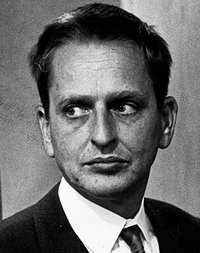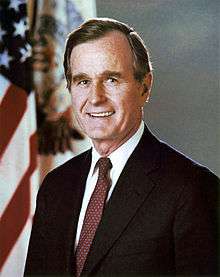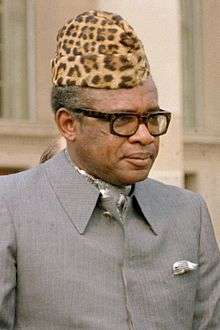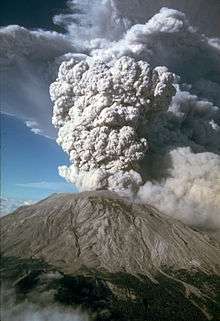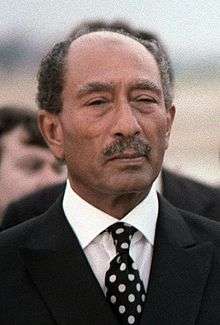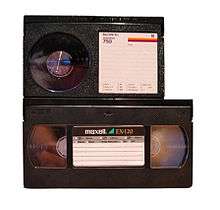1980s
| Millennium: | 2nd millennium |
| Centuries: | 19th century – 20th century – 21st century |
| Decades: | 1950s 1960s 1970s – 1980s – 1990s 2000s 2010s |
| Years: | 1980 1981 1982 1983 1984 1985 1986 1987 1988 1989 |
| 1980s-related categories: |
Births – Deaths – By country Establishments – Disestablishments |
The 1980s (pronounced "nineteen-eighties", commonly abbreviated as the "Eighties") was a decade of the Gregorian calendar that began on January 1, 1980, and ended on December 31, 1989.
The decade saw great socioeconomic change due to advances in technology and the low tax, high income economic policies that some first world leaders imposed at the time, resulting in an explosive growth of both large and small companies as a whole as they hired millions of more workers. Many economists at the very least agree that the changing global economic trends of the 1980s can be somewhat attributed to the "Reagan Boom", which, in the 1980s was a record setting era that produced more jobs and more economic expansion than any other time in U.S. history.
As economic liberalization increased in the developed world, multiple multinational corporations associated with the manufacturing industry relocated into Thailand, Mexico, South Korea, Taiwan, and China. Japan and West Germany saw large economic growth during this decade. The AIDS epidemic became recognized in the 1980s and has since killed an estimated 39 million people (as of 2013).[1] Global warming became well known to the scientific and political community in the 1980s.
The United Kingdom and the United States moved closer to supply-side economic policies beginning a trend towards global stability of international trade that would pick up more steam in the following decade as the fall of the USSR made right wing economic policy more popular.
Developing countries across the world faced economic and social difficulties as they suffered from multiple debt crises in the 1980s, requiring many of these countries to apply for financial assistance from the International Monetary Fund (IMF) and the World Bank. Ethiopia witnessed widespread famine in the mid-1980s during the corrupt rule of Mengistu Haile Mariam, resulting in the country having to depend on foreign aid to provide food to its population and worldwide efforts to address and raise money to help Ethiopians, such as the Live Aid concert in 1985.
Major civil discontent and violence occurred in the Middle East, including the Iran–Iraq War, the Soviet–Afghan War, the 1982 Lebanon War, the Nagorno-Karabakh War, the Bombing of Libya in 1986, and the First Intifada in the Gaza Strip and the West Bank. Islamism became a powerful political force in the 1980s and many terrorist organizations, including Al Qaeda started.
By 1986 nationalism was making a comeback in the Eastern Bloc and desire for democracy in communist-led socialist states combined with economic recession resulted in Mikhail Gorbachev's glasnost and perestroika, which reduced Communist Party power, legalized dissent and sanctioned limited forms of capitalism such as joint ventures with Western firms. After newly heated tension for most of the decade, by 1988 relations between the West and East had improved significantly [2] and the Soviet Union was increasingly unwilling to defend its governments in satellite states.
1989 saw the overthrow and attempted overthrow of a number of governments led by communist parties, such as in Hungary, the Tiananmen Square protests of 1989 in China, the Czechoslovak "Velvet Revolution", Erich Honecker's East German regime, Poland's Soviet-backed government, and the violent overthrow of the Nicolae Ceauşescu regime in Romania. The Cold War ended in the early 1990s with the successful Reunification of Germany and the USSR's demise after the August Coup of 1991.
The 1980s saw great advances in genetic and digital technology. After years of animal experimentation since 1985 the first genetic modification of 10 adult human beings took place in May 1989, a gene tagging experiment [3] which led to the first true gene therapy implementation in September 1990. The first "designer babies", a pair of female twins were created in a laboratory in late 1989 and born in July 1990 after being sex-selected via the controversial assisted reproductive technology procedure preimplantation genetic diagnosis.[4] Gestational surrogacy was first performed in 1985 with the first birth in 1986, making it possible for a woman to become a biological mother without experiencing pregnancy for the first time in history.[5]
The 1980s saw the advent of the ongoing practice of sex-selective abortion in China and India as ultrasound technology permitted parents to selectively abort baby girls. [6]
The global Internet took shape in academia by the second half of the 1980s as well as many other computer networks of both academic and commercial use such as USENET, Fidonet and the Bulletin Board System. By 1989 the Internet and the networks linked to it were a global system with extensive transoceanic satellite links and nodes in most rich countries.[7] Based on earlier work from 1980 onwards Tim Berners Lee formalized the concept of the World Wide Web by 1989 and performed its earliest demonstrations in December 1990 and 1991. Television viewing became commonplace in the Third World, with the number of TV sets in China and India increasing by 15 and 10 times respectively.[8]
Politics and wars
Terrorist attacks
The most notable terrorist attacks of the decade include:
- Bologna massacre in Italy on 2 August 1980, three members of the neo-fascist group Nuclei Armati Rivoluzionari detonate a time bomb at Bologna Central Station, killing 85 people.
- El Mozote massacre in El Salvador on December 11, 1981, against civilians, committed by government forces supported by the United States during their anti-guerrilla campaign against Marxist–Leninist rebels.
- The Rome and Vienna airport attacks took place on December 27, 1985, against the Israeli El Al airline. The attack was done by militants loyal to Abu Nidal, backed by the government of Libya.
- The 1983 Beirut barracks bombing – during the Lebanese Civil War two truck bombs struck separate buildings housing United States and French military forces killing 299 American and French servicemen. The organization Islamic Jihad claimed responsibility for the bombing.
- The 1984 anti-Sikh riots in India, committed by Hindu militants against Sikhs in response to the assassination of Indian Prime Minister Indira Gandhi by a Sikh militant. Thousands of people are killed and tens of thousands of Sikhs became displaced persons.
- Air India Flight 182 was destroyed on June 23, 1985, by Sikh-Canadian militants. It was the biggest mass murder involving Canadians in Canada's history.
- On December 21, 1988, Pan Am Flight 103 was blown up over the village of Lockerbie, Scotland, while en route from London's Heathrow Airport to New York's JFK. The bombing killed all 243 passengers, 16 crew members and 11 people on the ground, totaling 270 fatalities who were citizens of 21 nationalities. The bombing was and remains the worst terrorist attack on UK soil.
Wars
The most prominent armed conflicts of the decade include:
International wars

The most notable wars of the decade include:
- The Cold War (1945–1991)
- Soviet war in Afghanistan (1979–1989) – a war fought between the Soviet Union and the Islamist Mujahideen Resistance in Afghanistan. The mujahideen found other support from a variety of sources including the Central Intelligence Agency of the United States (see Operation Cyclone), as well as Saudi Arabia, Pakistan and other Muslim nations through the context of the Cold War and the regional India–Pakistan conflict.
- Invasion of Grenada (1983) – a 1983 U.S.-led invasion of Grenada, triggered by a military coup which ousted a brief revolutionary government. The successful invasion led to a change of government but was controversial due to charges of American imperialism, Cold War politics, the involvement of Cuba, the unstable state of the Grenadian government, and Grenada's status as a Commonwealth realm.
- Salvadoran Civil War (1980–1992) – part of the cold war conflicts, reached its peak in the 1980s, 70,000 Salvadorans died.
- Argentina invaded the Falkland Islands (or Islas Malvinas, as they are known in Spanish-speaking countries), sparking the Falklands War. It occurred from 2 April to 14 July 1982 between the United Kingdom and Argentina as British forces fought to recover the islands. Britain emerged victorious and its stance in international affairs and its long decaying reputation as a colonial power received an unexpected boost. The military junta of Argentina, on the other hand, was left humiliated by the defeat; and its leader Leopoldo Galtieri was deposed three days after the end of the war. A military investigation known as the Rattenbach report even recommended his execution.
- Arab–Israeli conflict (early 20th century – present)
- 1982 Lebanon War – the Government of Israel ordered the invasion as a response to the assassination attempt against Israel's ambassador to the United Kingdom, Shlomo Argov, by the Abu Nidal Organization and due to the constant terror attacks on northern Israel made by the terrorist organizations which resided in Lebanon. After attacking the PLO, as well as Syrian, leftist and Muslim Lebanese forces, Israel occupied southern Lebanon and eventually surrounded the PLO in west Beirut and subjected to heavy bombardment, they negotiated passage from Lebanon.
- In October 1985 eight Israeli F-15 Eagles carried out Operation Wooden Leg intending to bomb the PLO's new headquarters in Tunis, Tunisia, more than 2,000 km from Israel. The attack cost 270 lives, most of them Tunisian civilians. The attack was later condemned by the United Nations Security Council. The United States is thought to have assisted or known of the attack.
- The Iran–Iraq war took place from 1980 to 1988. Iraq was accused of using illegal chemical weapons to kill Iranian forces and against its own dissident Kurdish populations. Both sides suffered enormous casualties, but the poorly equipped Iranian armies suffered worse for it, being forced to use soldiers as young as 15 in human-wave attacks. Iran finally agreed to an armistice in 1988.
- The United States launched an aerial bombardment of Libya in 1986 in retaliation for Libyan support of terrorism and attacks on US personnel in Germany and Turkey.
- The South African Border War between South Africa and the alliance of Angola, Namibia and Zambia ended in 1989, ending over thirty years of conflict.
- The United States engaged in significant direct and indirect conflict in the decade via alliances with various groups in a number of Central and South American countries claiming that the U.S. was acting to oppose the spread of communism and end illicit drug trade. The U.S. government supported the government of Colombia's attempts to destroy its large illicit cocaine-trafficking industry and provided support for right-wing military government in the Salvadoran civil war which became controversial after the El Mozote massacre on December 11, 1981, in which U.S.-trained Salvadoran paramilitaries killed 1000 Salvadoran civilians. The United States, along with members of the Organisation of Eastern Caribbean States, invaded Grenada in 1983. The Iran–Contra affair erupted which involved U.S. interventionism in Nicaragua, resulting in members of the U.S. government being indicted in 1986. U.S. military action began against Panama in December 1989 to overthrow its dictator, Manuel Noriega resulting in 3,500 civilian casualties and the restoration of democratic rule.
- Battle of Cuito Cuanavale took place as part of the Angolan civil war and South African Border War from 1987 to 1988. The battle involved the largest fighting in Africa since World War II between military forces from Angola, Cuba (expeditionary forces) and Namibia versus military forces from South Africa and the dissident Angolan UNITA organization.
- The Nagorno-Karabakh War between Azerbaijan and the Armenia started in 1988 and lasted six years.
Civil wars and guerrilla wars
The most notable internal conflicts of the decade include:
- The Tiananmen Square protests of 1989 occurred in the People's Republic of China in 1989, in which pro-democracy protesters demanded political reform. The protests were crushed by the People's Liberation Army.
- The First Intifada (First Uprising) in the Gaza Strip and West Bank began in 1987 when Palestinian Arabs mounted large-scale protests against the Israeli military presence in the Gaza Strip and West Bank, largely inhabited by Palestinians. The First Intifada would continue until peace negotiations began between the Palestinian Liberation Organization (PLO) and the Israeli government in 1993.
- Lebanese Civil War (1975–1990) - Throughout the decade, Lebanon was engulfed in civil war between Islamic and Christian factions.
- The Kanak Socialist National Liberation Front began a violent campaign for independence in New Caledonia.
- Greenpeace's attempts to monitor French nuclear testing on Mururoa were halted by the sinking of the Rainbow Warrior.
- The Second Sudanese Civil War erupts in 1983 between the Muslim government of Sudan in the north and non-Muslim rebel secessionists in Southern Sudan. The conflict continues through the present day Darfur genocide.
- Internal conflict in Peru: The communist Túpac Amaru Revolutionary Movement starts its fight against the Peruvian state in 1980, that would continue until the end of the 1990s.
- Haitian dictator Jean-Claude Duvalier was overthrown by a popular uprising on February 6, 1986.
Coups
The most prominent coups d'état of the decade include:
- A military coup is launched in Suriname on February 25, 1980; the country's politics are dominated by the military until 1991.
- Nigeria suffered multiple military coups in 1983 and 1985.
- Sitiveni Rabuka staged two military coups in Fiji in 1987, and declared the country a republic the same year.
- The "Anti-Bureaucratic Revolution" - a series of interconnected coups d'états - take place in Yugoslavia from 1988 to 1989 through mass protests organized and committed by supporters of Serbian politician Slobodan Milošević overthrow the governments of Serbia's autonomous provinces of Kosovo and Vojvodina, and the government of Montenegro, and finally the main government of Serbia with Milošević becoming President of Serbia.
Nuclear threats

- Operation Opera - a 1981 surprise Israeli air strike that destroyed the Iraqi nuclear reactor being constructed in Osirak. Israeli military intelligence assumed this was for the purpose of plutonium production to further an Iraqi nuclear weapons program. Israeli intelligence also believed that the summer of 1981 would be the last chance to destroy the reactor before it would be loaded with nuclear fuel.
- US President Reagan's decision to station intermediate-range nuclear missiles in Western Europe provoked mass protests involving more than one million people.
Decolonization and independence
- In 1982, Canada gained official independence from the United Kingdom with the Canada Act 1982, authorized by the signature by Elizabeth II. This act severed all political dependencies of the United Kingdom in Canada (although the Queen remained the titular head of state).
- In 1986, Australia gained full independence from the United Kingdom with the Australia Act 1986, which severed the last remaining powers of the British government and monarchy over Australia's government, almost all of which had long been considered spent and obsolete.
- In 1986, New Zealand and the United Kingdom fully separated New Zealand's governments from the influence of the British Parliament, resulting in New Zealand's full independence with the Constitution Act 1986 which also reorganised the government of New Zealand.
- Independence was granted to Vanuatu from the British/French condonimum (1980), Kiribati from joint US-British government (1981) and Palau from the United States (1986).
- Zimbabwe becomes independent from official colonial rule of the United Kingdom in 1980.
- Independence was given to Antigua and Barbuda, Belize (both 1981), and Saint Kitts and Nevis (1983) in the Caribbean; and Brunei in the Far East in 1984
Prominent political events
Americas

- Ronald Reagan was elected U.S. President in 1980. In international affairs, Reagan pursued a hardline policy towards preventing the spread of communism, initiating a considerable buildup of U.S. military power to challenge the Soviet Union. He further directly challenged the Iron Curtain by demanding that the Soviet Union dismantle the Berlin Wall.
- The Reagan Administration accelerated the War on Drugs, publicized through anti-drug campaigns including the Just Say No campaign of First Lady Nancy Reagan. Drugs gained attention in the US as a serious problem in the '80s. Cocaine was relatively popular among celebrities and affluent youth, while crack, a cheaper offshoot of the drug, was linked to high crime rates in inner cities.
- Political unrest in the province of Quebec, which, due to the many differences between the dominant francophone population and the anglophone minority, and also to francophone rights in the predominantly English-speaking Canada, came to a head in 1980 when the provincial government called a public referendum on partial separation from the rest of Canada. The referendum ended with the "no" side winning majority (59.56% no, 40.44% yes).
- Military dictatorships give way to democracy in Argentina (1983), Uruguay (1984–5), Brazil (1985–8) and Chile (1988–9).
Europe
- The European Community's enlargement continued with the accession of Greece in 1981 and Spain and Portugal in 1986.
- In 1983 Bettino Craxi became the first socialist to hold the office of Prime Minister of Italy; he will remain in power until 1987. At the end of his presidency broke out the Mani pulite corruption scandal.
- Significant political reforms occurred in a number of communist countries in eastern Europe as the populations of these countries grew increasingly hostile and politically active in opposing communist governments. These reforms included attempts to increase individual liberties and market liberalization, and promises of democratic renewal. The collapse of communism in eastern Europe was generally peaceful, the exception being Romania, whose leader Nicolae Ceaucescu tried to keep the people isolated from the events happening outside the country. While making a speech in Bucharest in December 1989, he was booed and shouted down by the crowd, and then tried to flee the city with his wife Elena. Two days later, they were captured, charged with genocide, and shot on Christmas.
- In Yugoslavia, following the death of communist leader Josip Broz Tito in May 1980, the trend of political reform of the communist system occurred along with a trend towards ethnic nationalism and inter-ethnic hostility, especially in Serbia, beginning with the 1986 Memorandum of the Serbian Academy of Sciences and Arts followed by the agenda of Serbian communist leader Slobodan Milošević who aggressively pushed for increased political influence of Serbs in the late 1980s, condemning non-Serb Yugoslav politicians who challenged his agenda as being enemies of Serbs.
- There was continuing civil strife in Northern Ireland, including the adoption of hunger strikes by Irish Republican Army prisoners seeking the reintroduction of political status.
- Mikhail Gorbachev became leader of the Soviet Union in 1985, and initiated major reforms to the Soviet Union's government through increasing the rights of expressing political dissent and opening elections to opposition candidates (while maintaining legal dominance of the Communist Party). Gorbachev pursued negotiation with the United States to decrease tensions and eventually end the Cold War.
- At the end of the decade, the fall of the Berlin Wall in 1989 would be followed in 1990 by the German reunification. During 1989, most of the communist governments in Eastern Europe collapsed.
- The United Kingdom was governed by the Conservative Party under Prime Minister Margaret Thatcher, the first female leader of a Western country. Under her Premiership, the party introduced widespread economic reforms including the privatisation of industries and the de-regulation of stock markets echoing similar reforms of U.S. President Ronald Reagan. She was also a staunch opponent of communism earning her the nickname The Iron Lady.
- Poor industrial relations marked the beginning of the decade; the UK miners' strike (1984-1985) was a major industrial action affecting the UK coal industry. The strike by the National Union of Mineworkers (NUM) was led by Arthur Scargill, although some NUM members considered it to be unconstitutional and did not observe it. The BBC has referred to the strike as "the most bitter industrial dispute in British history."[9] At its height, the strike involved 142,000 mineworkers, making it the biggest since the 1926 General Strike.[10]
- In November 1982, Leonid Brezhnev, who had led the Soviet Union since 1964, died. He was followed in quick succession by Yuri Andropov, the former KGB chief, and Konstantin Chernenko, both of whom were in poor health during their short tenures in office.
Asia
- South Korean president Chun Doo Hwan came to power at the end of 1979 and ruled as a dictator until his presidential term expired in 1987. He was responsible for the Kwangju Massacre in May 1980 when police and soldiers battled armed protesters. Relations with North Korea showed little sign of improvement during the 1980s. In 1983, when Chun was in Burma, a bomb apparently planted by North Korean agents killed a number of South Korean government officials. After leaving office, he was succeeded by Roh Tae Woo, the first democratic ruler of the country, which saw its international prestige greatly rise with hosting the Olympics in 1988. Roh pursued a policy of normalizing relations with China and the Soviet Union, but had to face militant left-wing student groups who demanded reunification with North Korea and the withdrawal of US troops.
- In the Philippines, after almost 20 years of dictatorship, Philippine president Ferdinand Marcos left the presidency and was replaced by Corazon Aquino through the "People Power Revolution" from February 22 to 26, 1986. This has been considered by some a peaceful revolution despite the fact that the Armed Forces of the Philippines issued an order to disperse the crowds on EDSA (the main thoroughfare in Metro Manila).
Gallery of notable world leaders
Note: Names of country leaders shown below in bold face remained in power continuously throughout the entirety of the decade.
Disasters
Natural disasters
- Mount St. Helens erupted in Washington, U.S. on May 18, 1980, killing 57 people.
- On October 17, 1989, the Loma Prieta earthquake struck the San Francisco Bay Area during Game 3 of the 1989 World Series, gaining worldwide attention. Sixty-five people were killed and thousands injured, with major structural damage on freeways and buildings and broken gas-line fires in San Francisco, California. The cost of the damage totaled $13 billion (1989 USD).
- The US Drought of 1988 decimated the US with many parts of the country affected. This was the worst drought to hit the United States in many years. The drought caused $60 billion in damage (between $80 billion and $120 billion for 2008 USD). The concurrent heat waves killed 5,800 to 17,000 people in the United States.
- Hurricane Allen (1980), Hurricane Alicia (1983), Hurricane Gilbert (1988), Hurricane Joan (1988), and Hurricane Hugo (1989) were some notably destructive Atlantic hurricanes of the 1980s.
- Other natural disasters of the 1980s include the 1982–1983 El Niño which brought destructive weather to most of the world; the 1985 Mexico earthquake, which registered 8.1 on the Richter scale and devastated Mexico City and other areas throughout central Mexico; the 1985 Nevado del Ruiz lahar in Colombia; the 1986 Lake Nyos limnic eruption in Cameroon; and the 1988 Armenian earthquake, which rocked the Caucasus region of the USSR.
Non-natural disasters

- On April 25, 1980, Dan-Air Flight 1008 crashed on approach to Tenerife in the Canary Islands. All 146 people on board were killed.
- On August 19, 1980, Saudia Flight 163 caught fire moments after takeoff from the Saudi Arabian capital of Riyadh. The flight quickly returned to the airport, but evacuation of the plane was delayed and all 301 people aboard died.
- On July 9, 1982, Pan Am Flight 759 was forced down by a wind shear microburst, killing 153 people.
- In 1984, the Bhopal disaster resulted from a toxic MIC gas leak at the Union Carbide plant in Bhopal, India, killing 3,000 immediately and ultimately claiming 15,000–20,000 lives.
- On September 1, 1983, Soviet Union fighter jets shot down Korean Air Lines Flight 007, which was carrying 269 people, none of whom survived.
- On August 2, 1985, Delta Air Lines Flight 191 crashed on approach to Dallas-Fort Worth International Airport in Texas. 137 people were killed while 27 survived.
- Japan Airlines Flight 123, carrying 524 people, crashed on August 12, 1985 while on a flight from Tokyo to Osaka killing 520 of the people on board, leaving four survivors. This was, and still is, the worst single-plane crash ever.
- On December 12, 1985, Arrow Air Flight 1285 crashed seconds after lifting off from Gander, Newfoundland. All 256 people on board, many of them U.S. servicemen returning home from duty overseas, perished.
- On January 28, 1986, the NASA Space Shuttle Challenger disintegrated 73 seconds after launch, killing all of the crew on board. This was the first disaster involving the destruction of a NASA space shuttle. A faulty O-ring was the cause of the accident.
- On April 26, 1986, the Chernobyl disaster, a large-scale nuclear meltdown in the Ukrainian SSR, Soviet Union, spread a large amount of radioactive material across Europe, killing 47 people, dooming countless others to future radiation-related cancer, and causing the displacement of 300,000 people.
- On August 31, 1986, Aeroméxico Flight 498 crashed after colliding with a private Piper Cherokee over Cerritos, California, killing everyone on both airplanes and several others on the ground. On the same day, the Soviet passenger ship Admiral Nakhimov sank after colliding with the bulk carrier Pyotr Vasev in the Black Sea, killing 423 people.
- On May 9, 1987, an uncontained engine failure on LOT Flight 5055 caused an in-flight fire on board the airliner, which subsequently crashed, killing all 183 passengers and crew.
- On August 16, 1987, Northwest Airlines Flight 255 crashed almost immediately after takeoff from Detroit Wayne Airport in Michigan, killing 156 people.
- On November 28, 1987, a fire broke out on South African Airways Flight 295, eventually causing the aircraft to crash into the Indian Ocean. All 159 aboard were killed.
- On December 7, 1987, 43 people were killed when an irate former USAir employee went on a rampage aboard PSA Flight 1771.
- On December 20, 1987, the Philippine passenger ferry MV Doña Paz burned and sank after colliding with the oil tanker MT Vector. With an estimated death toll of over 4,000, this was and remains the world's deadliest peacetime maritime disaster.
- On July 3, 1988, Iran Air Flight 655 was shot down by the U.S. missile cruiser USS Vincennes over the Strait of Hormuz, killing all 290 people on the plane. The event is one of the most controversial aviation occurrences of all time, with the true cause disputed between the Americans and the Iranians.
- On March 24, 1989, the oil tanker Exxon Valdez ran aground on Bligh Reef in Alaska's Prince William Sound spilling an estimated equivalent of 260,000 to 750,000 barrels of crude oil. Although not among the largest oil spills in history, its remote and sensitive location made it one of the most devastating ecological disasters ever. The after effects of the spill continue to be felt to this day.
- On July 19, 1989, United Airlines Flight 232, carrying 296 people, suffered an in-flight engine failure and was forced to crash-land at Sioux City, Iowa. 185 survived, while 111 were killed when the plane burst into flames upon touchdown.
Assassinations
The 1980s were marked by several notable assassinations and assassination attempts:
- On April 12, 1980, William R. Tolbert, Jr., the President of Liberia, is killed during a military coup. His death marks the end of Americo-Liberian rule in Liberia.
- Musician and former member of The Beatles John Lennon was assassinated in New York City on December 8, 1980.
- Ronald Reagan was shot in Washington, D.C. on March 30, 1981 by John Hinckley, a mentally disturbed young man who also stalked actress Jodie Foster. Reagan's press secretary James Brady was also shot, along with a police officer and a U.S. Secret Service agent. The latter two recovered, along with Reagan himself, but Brady used a wheelchair as a result of brain damage thereafter and would become an advocate of gun control.
- In May 1981, there was an assassination attempt on Pope John Paul II in Saint Peter's Square. The would-be assassin was a Turkish man named Mehmet Ali Agca, who was subsequently sentenced to life in prison, but would be pardoned in 2000. At the time, it was widely believed that he was an agent of the Soviet Union or Bulgaria, due to the Pope's vocal anti-communist stance. Agca himself told dozens of conflicting stories over the years, and his motive remains unclear.
- Egyptian president Anwar Sadat was assassinated at a military parade in Cairo on October 6, 1981.
- Philippine Opposition Senator Benigno Aquino, Jr. was assassinated in Manila on August 21, 1983.
- American singer-songwriter and musician Marvin Gaye was shot dead by his father at his home in Los Angeles on April 1, 1984.
- Indian prime minister Indira Gandhi was assassinated on October 31, 1984 by her own bodyguards in response to the Indian Army's attack on Golden Temple to destroy Sikh Militant stronghold in Amritsar earlier in the decade.
- In 1984, there was an assassination attempt on the British Prime Minister, Margaret Thatcher and the Conservative Government by the IRA.
- Swedish Prime Minister Olof Palme was assassinated in February 1986. The assassin has never been identified.
- On October 15, 1987, the President of Burkina Faso, Thomas Sankara, was killed during a coup d'état organised by his former colleague, Blaise Compaoré.
Technology
Medicine and Biology
The 1980s had many fundamental advances in medicine and biology. The first surrogate pregnancy of an unrelated child took place on April 13, 1986 in Michigan.[5] The first genetically modified crops, tobacco plants were grown in China in 1988.[11]
Gene therapy techniques became established by the end of the 1980s, allowing gene tagging and gene therapy to become a possibility, both of which were first performed in human beings in May 1989 and September 1990 respectively.
Electronics and computers
Arcade games and video games had been growing in popularity since the late 1970s, and by 1982 were a major industry. But a variety of factors, including a glut of low-quality games and the rise of home computers, caused a tremendous crash in late 1983. For the next three years, the video game market practically ceased to exist in the US. But in the second half of the decade, it would be revived by Nintendo, whose Famicom console and mascot Mario had been enjoying considerable success in Japan since 1983. Renamed the Nintendo Entertainment System, it would claim 90% of the American video game market by 1989. The 1980s are considered to be the decade when video games achieved massive popularity. In 1980 Pac-Man was introduced to the arcades, and became one of the most popular video games of all time. Also in 1980, Mr. Game and Watch was created; it was not one of the most well known game systems, but it facilitated mini-games and was concurrent with the NES. Donkey Kong, released in 1981, was a smash arcade hit and market breakthrough for Nintendo. Super Mario Bros., Super Mario Bros. 2, SMB3, The Legend of Zelda, and the Mega Man series would become major hits for the NES.
The Personal computer experienced explosive growth in the 1980s, transitioning from a hobbyist's toy to a full-fledged consumer product. The IBM PC, launched in 1981, became the dominant computer for professional users. Commodore created the most popular home computers of both 8-bit and 16-bit generations. MSX standard was the dominant computer platform in Japan and in most parts of Asia. Apple superseded its Apple II and Lisa models by introducing the first Macintosh computer in 1984. It was the first commercially successful personal computer to use a graphical user interface and mouse,[12] which started to become general features in computers after the middle of the decade.
-

Commodore 64, with sales estimated at more than 17 million units in 1982–1994 became the best-selling computer model of all time.
-

The Macintosh 128K, the first commercially successful personal computer to use a graphical user interface, was introduced to the public in 1984.[1]
- ^ Linzmayer, Owen W. (2004). Apple Confidential 2.0. No Starch Press. p. 113. ISBN 1-59327-010-0.
- ^ Knight, Gareth (2002-06-17). "A500 Batman Bundle". Amigahistory.co.uk. Retrieved 2013-07-24.
Walkman and Boomboxes, invented during the late 1970s, became very popular as they were introduced to various countries in the early 1980s, and had a profound impact on the Music industry and youth culture. Consumer VCRs and video rental stores became commonplace as VHS won out over the competing betamax standard. In addition, in the early 1980s various companies began selling compact, modestly priced synthesizers to the public. This, along with the development of Musical Instrument Digital Interface (MIDI), made it easier to integrate and synchronize synthesizers and other electronic instruments, like drum machines, for use in musical composition.
High definition television (HDTV) of both the analog and digital variety were first developed in the 1980s though their use did not become widespread until the mid-2000s.
-
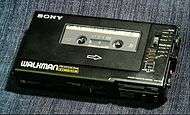
Walkman WM-D6C Pro (1984)
-

1980s Boombox
-
1980s Synthesizer (Yamaha DX7)
Space exploration

American interplanetary probes continued in the 1980s, the Voyager duo being the most known. After making a flyby of Jupiter in 1979, they went near Saturn in 1980–1981. Voyager 2 reached Uranus in 1986 (just a few days before the Challenger disaster), and Neptune in 1989 before the probes exited the solar system.
No American probes were launched to Mars in the 1980s, and the Viking probes, launched there in 1975, completed their operations by 1982. The Soviets launched two Mars probes in 1988, but they failed.
The arrival of Halley's Comet in 1986 was met by a series of American, Soviet, Japanese, and ESA probes.
After a five-year hiatus, manned American space flights resumed with the launch of the space shuttle Columbia in April 1981. The shuttle program progressed smoothly from there, with three more orbiters entering service in 1983–1985. But that all came to an end with the tragic loss of the Challenger on January 28, 1986, taking with it seven astronauts, including Christia McAuliffe, who was to have been the first teacher in space. In full view of the world, a faulty O-ring on the right solid rocket booster allowed hot gases to burn through the external fuel tank and cause it to explode, destroying the shuttle in the process. Extensive efforts were made to improve NASA's increasingly careless management practices, and to make the shuttle safer. Flights resumed with the launch of Discovery in September 1988.
The Soviet manned program went well during the decade, experiencing only minor setbacks. The Salyut 6 space station, launched in 1977, was replaced by Salyut 7 in 1982. Then came Mir in 1986, which ended up operating for more than a decade, and was destined to be the last in the line of Soviet space stations that had begun in 1971. One of the Soviet Union's last "superprojects" was the Buran space shuttle; it was only used once, in 1988.
Automobiles
The American auto industry began the 1980s in a thoroughly grim situation, faced with poor quality control, rising import competition, and a severe economic downturn.[13] Chrysler and American Motors (AMC) were near bankruptcy, and Ford was little better off.[14] Only GM continued with business as usual. But the auto makers recovered with the economy by 1983, and in 1985 auto sales in the United States hit a new record. However, the Japanese were now a major presence, and would begin manufacturing cars in the US to get around tariffs. In 1986, Hyundai became the first Korean auto maker to enter the American market. In the same year, the Yugoslavian-built Yugo was brought to the US, but the car was so small and cheap, that it became the subject of jokes. It was sold up to 1991, when economic sanctions against Yugoslavia forced its withdrawal from the American market.
As the decade progressed, cars became smaller and more efficient in design. In 1983, Ford design teams began to incorporate aerodynamic styling to decrease drag while in motion. The Thunderbird was one of the first cars to receive these design changes. In 1985, Ford released the Taurus with a design that was revolutionary among domestic mass market automobiles.
General Motors began suffering significant losses in the late-1980s, partially the result of chairman Roger Smith's restructuring attempts, and partially because of increasingly dated cars. An example were customers who increasingly purchased European luxury cars rather than Cadillacs. In 1985, GM started Saturn (the first new American make since the Edsel), with the goal of producing high-quality import fighters. Production would not begin until 1990.
Chrysler introduced its new compact, front-wheel drive K-cars in 1981. Under the leadership of Lee Iacocca, the company turned a profit again the following year, and by 1983 paid off its government loans. A succession of models using this automobile platform followed. The most significant were the minivans in 1984. These proved a to be popular and they would dominate the van market for more than a decade. In 1987, Chrysler purchased the Italian makes of Lamborghini and Maserati. In the same year, Chrysler bought AMC from Renault laying to rest the last significant independent U.S. automaker, but acquiring the hugely profitable Jeep line and continuing the Eagle brand until the late 1990s.[15]
The DeLorean DMC-12 was the brainchild of John DeLorean, a flamboyant former GM executive. Production of the gull-winged sports car began in Northern Ireland in 1981. John DeLorean was arrested in October 1982 in a sting operation where he was attempting to sell cocaine to save his struggling company. He was acquitted of all charges in 1984, but too late for the DeLorean Motor Company, which closed down in 1983. The DMC-12 gained renewed fame afterward as the time machine in the Back to the Future motion picture trilogy.
The imposition of CAFE fuel-mileage standards in 1979 spelled the end of big-block engines, but performance cars and convertibles reemerged in the 1980s. Turbochargers were widely used to boost the performance of small cars, and technology from fuel injection began to take over from the widely used application of carburetors by the late 1980s. Front-wheel drive also became dominant.
The eighties marked the decline of European brands in North America by the end of the decade. Renault, Citroen, and Peugeot ceased importation by the end of the decade. Alfa Romeo would continue until 1993. Fiat also ceased imports to North America in the eighties.
Economics
- The early 1980s was marked by a severe global economic recession that affected much of the developed world.
- Inflation peaked in the U.S. in April 1980 at 14.76% and subsequently fell to a low of 1.10% in December 1986 but then rebounded to 4.65% at the end of the decade.On the other hand, Finland's economy grew by almost the fastest pace in the world, which eventually culminated in the recession of the 1990s Finnish economy. In Finland, the 1980s were called the "Nousukausi", or "economic upswing"[16]
- International debt crisis in developing countries, reliance of these countries on aid from the International Monetary Fund.
- Revival of laissez faire/neoliberal economics in the developed world led by the UK and US governments emphasising reduced government intervention, lower taxes and deregulation of the stock markets associated with an economic revival in the mid- to late '80s. Consumers became more sophisticated in their tastes (a trend begun in the 1960s), and things such as European cars and designer clothing became fashionable in the US.
- Mexico suffers from a debt crisis starting in 1982. Economic problems worsened in 1985 by resignation of most officials of the Mexican government after a failed response of emergency aid in the Mexico City earthquake (September 19) just after the 175th anniversary of Independence holiday (September 16). In 1988, Carlos Salinas de Gortari won a controversial presidential election amid charges of voter fraud, bribery, corruption and other abuses of power.
- Enactment of the Canada-United States Free Trade Agreement in 1989 to further establish a strong economic bond between the two prosperous neighbor countries of North America.
- In the Soviet Union, the eleventh Five-Year Plan was initiated in 1981 during a period of economic stagnation that began in the late 1970s. The Plan was a near failure, as most of the targets were not met. With the ascent of Mikhail Gorbachev as General Secretary of the Communist Party, the twelfth Five-Year Plan sought to accelerate and restructure the Soviet economy through reforms to decentralize production and distribution systems.
- Under the leadership of Deng Xiaoping, China embarked on extensive reforms in the 1980s, opening the country's economy to the West and allowing capitalist enterprises to operate in a market socialist system. The corruption of Communist Party leadership was met by dissent from students and workers in the Tiananmen Square protests of 1989 which were suppressed by the People's Liberation Army.
- The Solidarity movement began in Poland in 1980, involving workers demanding political liberalization and democracy in Poland. Attempts by the Communist government to prevent the rise the Solidarity movement failed and negotiations between the movement and the government took place. Solidarity would be instrumental in encouraging people in other communist states to demand political reform.
- The financial world and the stock market were glamorized in a way they had not been since the 1920s, and figures like Donald Trump and Michael Milken were widely seen as symbols of the decade. Widespread fear of Japanese economic strength would grip the United States in the '80s.
- During the 1980s, for the first time in world history, transpacific trade (with East Asia, such as China, and Latin America, primarily with Mexico) equaled that of transatlantic trade (with Western Europe or with neighboring Canada),[17] solidifying American economic power.[18]
- The Savings and Loan Scandal.
Society
The 1980s was also an era of tremendous population growth around the world, surpassing even the 1970s and 1990s, thus arguably being the largest in human history. Population growth was particularly rapid in a number of African, Middle Eastern, and South Asian countries during this decade, with rates of natural increase close to or exceeding 4% annually.
Popular culture
The most prominent events and trends in popular culture of the decade include:
Music
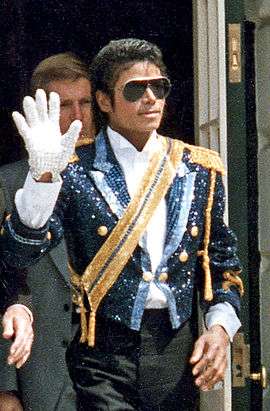

In the United States, MTV was launched and music videos began to have a larger effect on the record industry. Pop artists such as Michael Jackson, Whitney Houston, Duran Duran, Prince, and Madonna mastered the format and helped turn this new product into a profitable business. New wave and synthpop were developed by many British and American artists, and became popular phenomena throughout the decade, especially in the early and mid-eighties. Music grew fragmented and combined into subgenres such as house, goth, and rap metal.[19]
Michael Jackson was one of the definitive icons of the 1980s and his leather jacket, glove, and Moonwalk dance were often imitated. Jackson's 1982 album Thriller became—and currently remains—the best-selling album of all time, with sales estimated by various sources as somewhere between 65 and 110 million copies worldwide.
Madonna and Whitney Houston are regarded by many as the most groundbreaking female artists of the decade. The keyboard synthesizer and drum machine were among the most popular instruments in music during the 1980s, especially in new wave music. After the 1980s electronic instruments were no longer popular in rock but continued to be the main component of mainstream pop.
Hard rock, heavy metal, and glam metal became some of the most dominant music genres of the decade, peaking with the arrival of such bands as Mötley Crüe, Guns N' Roses, Metallica, Iron Maiden, Bon Jovi, Def Leppard, Poison, Europe, Megadeth, Slayer, Anthrax, and virtuoso guitarists such as Joe Satriani and Yngwie Malmsteen. The scene also helped 1970s hard rock artists such as AC/DC, Heart, Ozzy Osbourne, Black Sabbath, Deep Purple, Queen, Van Halen, KISS, Ronnie James Dio, and Judas Priest reach a new generation of fans.
By 1989, the hip hop scene had evolved, gaining recognition and exhibiting a stronger influence on the music industry. This time period is also considered part of the golden age of hip hop. The Beastie Boys, Public Enemy, Run-D.M.C., Grandmaster Flash, the Furious Five, Boogie Down Productions, N.W.A, LL Cool J, De La Soul, A Tribe Called Quest, EPMD, Eric B. & Rakim, Ice-T, DJ Jazzy Jeff & The Fresh Prince, 2 Live Crew, Tone Lōc, Biz Markie, the Jungle Brothers, The Sugar Hill Gang and others experienced success in this genre.
Ex-Beatle John Lennon released his last album, Double Fantasy, in 1980 and won Album of the Year at the 1982 Grammy Awards.
Country music came to the forefront with youth appeal and record-breaking marks. Groundbreaking artists such as Alabama and Hank Williams Jr. achieved multiple platinum and award status.
The techno style of electronic dance music emerged in Detroit, Michigan, during the mid- to late 1980s. The house music style, another form of electronic dance music, emerged in Chicago, Illinois, in the early 1980s. It was initially popularized in mid-1980s discothèques catering to the African-American, Latino and gay communities, first in Chicago, then in New York City and Detroit. It eventually reached Europe before becoming infused in mainstream pop and dance music worldwide.
Punk rock continued to make strides in the musical community. With bands leading the significance of this period such as Black Flag, Bad Brains, Minor Threat, Suicidal Tendencies, D.O.A., Bad Religion, Minutemen, Social Distortion, and Dead Kennedys, it gave birth to many subgenres like hardcore, which has continued to be moderately successful, giving birth in turn to a few counterculture movements, most notably the Straight Edge movement which began in the early era of this decade. College rock caught on in the underground scene of the 1980s in a nationwide movement with a distinct D.I.Y approach. Bands like the Pixies, R.E.M., The Replacements, Sonic Youth, XTC, The Smiths, Hüsker Dü, The Stone Roses, The Jesus and Mary Chain etc. experienced success in this genre. The 1980s also saw the birth of the grunge genre, with the arrival of such bands as Soundgarden, Green River, Melvins, Screaming Trees, Malfunkshun, Skin Yard, The U-Men, Blood Circus, Nirvana, Tad, Mudhoney, Mother Love Bone and Alice in Chains (who formed in 1987, but did not release their first album until three years later).
Several notable music artists died of unnatural causes in the 1980s. Bon Scott, at the time lead singer of rock band AC/DC, died of acute alcohol poisoning on February 19, 1980. English drummer John Bonham of the rock band Led Zeppelin also died that year in similar fashion. John Lennon was shot outside his home in New York City on the night of December 8, 1980. Tim Hardin died of a heroin overdose on December 29, 1980. Bob Marley died from a lentiginous skin melanoma on May 11, 1981. Marvin Gaye was shot dead by his father at his home in Los Angeles on April 1, 1984, one day before what would have been his 45th birthday. Ozzy Osbourne's guitarist Randy Rhoads died in an airplane crash on March 19, 1982. Karen Carpenter died from heart failure caused by her anorexia condition on February 4, 1983. Metallica bassist Cliff Burton was killed in a bus accident in Sweden on September 27, 1986. Andy Gibb died in 1988 as a result of myocarditis.
1985's Live Aid concert, featuring many artists, promoted attention and action to send food aid to Ethiopia whose people were suffering from a major famine.
Film
- Oscar winners for Best Picture: Ordinary People (1980), Chariots of Fire (1981), Gandhi (1982), Terms of Endearment (1983), Amadeus (1984), Out of Africa (1985), Platoon (1986), The Last Emperor (1987), Rain Man (1988), Driving Miss Daisy (1989).
- The highest-grossing films of the decade are (in order from highest to lowest domestic grossing): E.T. the Extra-Terrestrial, Return of the Jedi, The Empire Strikes Back, Indiana Jones and the Last Crusade, Batman, Rain Man, Raiders of the Lost Ark, Back to the Future, Who Framed Roger Rabbit, Top Gun, Indiana Jones and the Temple of Doom, Back to the Future Part II, "Crocodile" Dundee, Fatal Attraction and Beverly Hills Cop.[20]
The 1980s saw the return of studio-driven films, coming from the filmmaker-driven New Hollywood era of the 1970s.[21] The period was when 'high concept' films gained popularity, where movies were to be easily marketable and understandable, and, therefore, they had short cinematic plots that could be summarized in one or two sentences. The modern Hollywood blockbuster is the most popular film format from the 1980s. Producer Don Simpson[22] is usually credited with the creation of the high-concept picture of the modern Hollywood blockbuster.
The '80s also spawned the Brat Pack films, many of which were directed by John Hughes. Films such as Class, The Breakfast Club, Fast Times at Ridgemont High, Mannequin, Porky's, Pretty in Pink, Sixteen Candles, St. Elmo's Fire, Ferris Bueller's Day Off, Weird Science, and Valley Girl were popular teen comedies of the era and launched the careers of several major celebrities such as: Emilio Estevez, Anthony Michael Hall, Forest Whitaker, Jennifer Jason Leigh, Andrew McCarthy, Judd Nelson, Molly Ringwald, Sean Penn, Nicolas Cage and Michael J Fox. Other popular films included About Last Night..., Bill & Ted's Excellent Adventure, Dirty Dancing, Flashdance, Footloose, Raging Bull and St. Elmo's Fire which also launched the careers of high-profile celebrities like Demi Moore, Joe Pesci, Keanu Reeves, Kevin Bacon, Rob Lowe, and Patrick Swayze.
Horror films were a popular genre during the decade, with several notable horror franchises being born during the 1980s. Among the most popular were the Child's Play, A Nightmare on Elm Street, Friday the 13th, Hellraiser, and Poltergeist franchises. Aside from these films, the concept of the B horror film gave rise to a plethora of horror films that went on to earn a cult status. An example of such is the 1981 film The Evil Dead, which marked the directorial debut of Sam Raimi.
Several action film franchises were also launched during the 1980s. The most popular of these were the Beverly Hills Cop, Die Hard, Lethal Weapon, and Rambo franchises. Other action films from the decade which are of notable status include The Terminator, and Predator. These films propelled the careers of modern celebrities such as Arnold Schwarzenegger, Bruce Willis, Eddie Murphy, Mel Gibson, and Sylvester Stallone to international recognition.
Five more James bond films were released, with Roger Moore continuing in the role for the first three, before handing over to Timothy Dalton.
A significant development in the home media business is the establishment of The Criterion Collection in 1984, an American company "dedicated to gathering the greatest films from around the world and publishing them in editions that offer the highest technical quality". Through their releases, they were able to introduce what is now a standard to home video: letterboxing to retain the original aspect ratio, film commentaries and supplements/special features.[23][24]
Television
MTV was launched in the United States in 1981 and had a profound impact on the music industry and popular culture further ahead, especially during its early run in the 1980s and early 1990s.
Some of the most popular TV series which premiered during the 1980s or carried over from the 1970s include: Alf, Airwolf, The A-Team, The Love Boat, Lou Grant, The Incredible Hulk, Too Close For Comfort, The Dukes of Hazzard, Trapper John, M.D., Diff'rent Strokes, Dynasty, Dallas, Knots Landing, One Day at a Time, Alice, Falcon Crest, Knight Rider, Newhart, Pee-Wee's Playhouse, Gimme a Break!, Punky Brewster, Taxi, Happy Days, St. Elsewhere, MacGyver, L.A. Law, Magnum, P.I., M*A*S*H, Barney Miller, WKRP in Cincinnati, Laverne & Shirley, Mork & Mindy, Miami Vice, The Jeffersons, The Facts of Life, Hill Street Blues, St. Elsewhere, The Cosby Show, Highway To Heaven, Murder, She Wrote, 227, Matlock, Star Trek: The Next Generation, Night Court, Who's the Boss?, Family Matters, Charles in Charge, The Hogan Family, Perfect Strangers, Designing Women, Amen, Head of the Class, Murphy Brown, The Wonder Years, Empty Nest, Coach, Doogie Howser M.D., Quantum Leap, Saved by the Bell, Roseanne, Full House, The Golden Girls,Three's Company, Cheers, Growing Pains, Benson, Soap, Family Ties, Seinfeld, The Simpsons, the World Wrestling Federation (WWF), Married... with Children, Dragon Ball, and Moonlighting.
The 1980s was the decade of transformation in television. Cable television became more accessible and therefore, more popular. By the middle of the decade, almost 70% of the American population had cable television and over 85% were paying for cable services such as HBO or Showtime.[25]
The 1980s also saw the debut of prime-time soap operas such as Dallas, its spin-off Knots Landing, Dynasty, Falcon Crest, EastEnders and Neighbours.
TV talk shows expanded in popularity; The Tonight Show Starring Johnny Carson remained popular into its third decade, and some of the most viewed newer shows were hosted by Geraldo Rivera, Arsenio Hall and David Letterman.[26]
The 1980s also was prominent for spawning several popular children's cartoons such as The Smurfs, ThunderCats, Voltron, The Transformers, Masters of the Universe, G.I. Joe: A Real American Hero, Inspector Gadget, Muppet Babies, Teenage Mutant Ninja Turtles, DuckTales, Garfield and Friends, and Beetlejuice.
Sports
- The 1980 Summer Olympics in Moscow were disrupted by a boycott led by the United States and 64 other countries in protest of the 1979 Soviet invasion of Afghanistan.
- The 1980 Winter Olympics were well remembered for the Miracle on Ice, where a young United States hockey team defeated the heavily favored Soviet Red Army team and went on to win the gold medal.
- The New York Islanders won the Stanley Cup for 4 straight years in 1980, 1981, 1982, and 1983. The Islanders also became the second NHL expansion team after the Philadelphia Flyers to win the Cup. Since their last Cup win in 1983, they were the third NHL team to win 4 consecutive championships and hold the NHL record for most consecutive playoff series' wins at 19(1980 Playoffs - 1984 Playoffs).
- The 1984 Summer Olympics in Los Angeles were boycotted by the Soviet Union and most of the Communist world (China, Romania, and Yugoslavia participated in the games) in retaliation for the boycott of the 1980 Games in Moscow.
- The 1984 Winter Olympics were held in Sarajevo, Yugoslavia (now Sarajevo, Bosnia and Herzegovina). Yugoslavia became the second communist country to host the Olympic Games, but unlike the Soviet Union in 1980, there were no boycotts of the Games by Western countries.
- The Jamaica national bobsled team received major media attention and stunned the world at the 1988 Winter Olympics in Calgary, Alberta, Canada for its unexpected good performance. The events surrounding the Jamaica bobsled team in 1988 would lead to the creation of the Disney movie Cool Runnings five years later.
- The 1988 Summer Olympics were held in Seoul, South Korea. Attempts to include North Korea in the games were unsuccessful and it boycotted along with six other countries, but with 160 nations participating, it had the highest attendance of any Olympics to date.
- FIA bans Group B rallying after a series of deaths and injuries take place in the 1986 season.
- Canadian hockey player Wayne Gretzky's rise to fame in the NHL coincided with the Edmonton Oilers' first 4 Stanley Cup championships (1984, 1985, 1987, and 1988) and becoming the second NHL dynasty team of the 1980s.
- On August 9, 1988, in what became the biggest trade in NHL history (also known as "The Trade Of The Century"), Wayne Gretzky was traded along with teammates Marty McSorley and Mike Krushelnyski from Edmonton to the Los Angeles Kings in exchange for Martin Gelinas, Jimmy Carson, three first round draft picks, and US$15 million cash (approximately $18 million CAD in 1988).
- American basketball player Michael Jordan burst onto the scene in the NBA during the 1980s, bringing a surge in popularity for the sport and becoming one of the most beloved sports icons in the United States.
- On June 8, 1986 the Boston Celtics defeat the Houston Rockets in Game 6 of the 1986 NBA Finals to capture a record 16th championship. Larry Bird is named Finals MVP.
- On November 26, 1986 Mike Tyson became the youngest boxing Heavyweight Champion in history at age 20.
- On March 31, 1985 The WWF presented the first WrestleMania at Madison Square Garden in New York City with an attendance of 19,121.
- On March 29, 1987 WrestleMania III had a record attendance of 93,173; the largest recorded attendance for a live indoor sporting event in North America until 2010. This also remained the WrestleMania attendance record until WrestleMania 32 at AT&T Stadium on April 3, 2016 in Arlington, Texas
- West Germany won the 1980 UEFA championship.
- Italy won the 1982 FIFA World Cup in Spain.
- France hosted and won the 1984 UEFA championship.
- Argentina won the 1986 FIFA World Cup in Mexico.
- The Netherlands won the 1988 UEFA championship.
- Hawthorn Football Club dominated Australian football, reaching seven successive VFL Grand Finals and winning the premiership in 1983, 1986, 1988, and 1989
- Liverpool F.C. were the most successful club side of the era, becoming English champions on six occasions (1980, 1982, 1983, 1984, 1986, and 1988) and winning two European Cups (1981, 1984). They also won the FA Cup in 1986, completing the first double in their history, and four consecutive League Cup titles from 1981 to 1984.
- Other highly successful club sides of the 1980s include Juventus (7 major honours won), Real Madrid (10 major honors won), Bayern Munich (9 titles won) PSV Eindhoven (4 times Dutch champions and European Cup winners in 1988), and Flamengo (4 times Brazilian champions, South American and International Cup winners in 1981).
- The San Francisco 49ers won four Super Bowls during the decade led by Joe Montana; the Chicago Bears won Super Bowl XX in January 1986, in which the team has been widely remembered for their defense.
- Magic Johnson and Larry Bird became the two most popular NBA players during the decade while even facing against each other in three NBA Finals(1984, 1985, and 1987) continuing the storied Celtics-Lakers rivalry.
- Disc ultimate league play is introduced to Canada in 1980 by Ken Westerfield starting the first disc ultimate league (TUC), in Toronto.
Video gaming


Popular video games include: Pac-Man, Super Mario Bros., The Legend of Zelda, Metroid, Donkey Kong, Frogger, Digger, Tetris, and Golden Axe. Pac-Man (1980) was the first game to achieve widespread popularity in mainstream culture and the first game character to be popular in his own right. Handheld electronic LCD games was introduced into the youth market segment. The primary gaming computers of the 1980s emerged in 1982: the Commodore 64 and ZX Spectrum. Nintendo finally decided in 1985 to release its Famicom (released in 1983 in Japan) in the United States under the name Nintendo Entertainment System (NES). It was bundled with Super Mario Bros. and it suddenly became a success. The NES dominated the American and Japanese market until the rise of the next generation of consoles in the early 1990s, causing some to call this time the Nintendo era. Sega released its 16-bit console, Mega Drive/Genesis, in 1988 in Japan and in North America in 1989. In 1989 Nintendo released the Game Boy, a monochrome handheld console.
Fashion
The beginning of the decade saw the continuation of the clothing styles of the late 1970s and evolved into heavy metal fashion by the end; This included teased hair, ripped jeans, and neon clothing.
Significant hairstyle trends of the 1980s include the perm, the mullet, the Jheri curl,the hi-top fade, and big hair.
Significant clothing trends of the 1980s include shoulder pads, jean jackets, leather pants, aviator jackets, jumpsuits, Members Only jackets, skin-tight acid-washed jeans, Izod and "Preppy" polo shirts, miniskirts, leggings and leg warmers (popularized in the film Flashdance), off-the-shoulder shirts, and cut sweatshirts (again, popularized in the film Flashdance).
Additional significant trends of the 1980s include headbands, Ray-Ban Aviator sunglasses (popularized in the film Top Gun), Ray-Ban Wayfarer sunglasses (popularized in the films Risky Business and The Blues Brothers), Swatch watches, and the Rubik's Cube (became a popular fad throughout the decade). Girls also wore jelly shoes, large crucifix necklaces, and braissers all inspired by Madonna's "Like a Virgin" music video.
-

Tom Bailey of the Thompson Twins in 1986 with the trendy Big hair style achieved with liberal applications of mousse and hairspray.
-
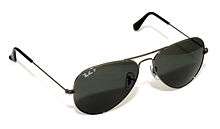
Ray-Ban sunglasses
-

Trendy 1980s pleated acid-washed jeans
See also
- 1980s in music
- 1980s in fashion
- 1980s in television
- 1980s in video gaming
- 1980s in literature
- Hairstyles in the 1980s
Timeline
The following articles contain brief timelines which list the most prominent events of the decade:
1980 • 1981 • 1982 • 1983 • 1984 • 1985 • 1986 • 1987 • 1988 • 1989
References
- ↑ "Global HIV/AIDS Overview". aids.gov. Retrieved 16 April 2016.
- ↑ Lewis, Flora (May 29, 1988). "FOREIGN AFFAIRS; Cold War Recedes". New York Times.
- ↑ "recent advances in pediatrics-17". google.com. Retrieved 16 April 2016.
- ↑ "Genetic Defect Screened Out; Healthy Twins Born". latimes. Retrieved 16 April 2016.
- 1 2 "And Baby Makes Four: for the First Time a Surrogate Bears a Child Genetically Not Her Own". people.com. Retrieved 16 April 2016.
- ↑ https://www.guttmacher.org/about/journals/ipsrh/2011/09/sex-selective-abortions-during-past-three-decades-may-explain-absence
- ↑ "Research Handbook on Governance of the Internet". google.com. Retrieved 16 April 2016.
- ↑ Singhal, Arvind; Doshi, J.K.; Rogers, Everett M.; Rahman, S. Adnan. "The Diffusion of Television in India" (PDF). Media Asia. 15 (4): 222–229. Retrieved 2015-04-18.
- ↑ "1984: The beginning of the end for British coal". London: BBC News. Retrieved 20 December 2014.
- ↑ Strikes Around the World, 1968-2005: Case-studies of 15 Countries. Amsterdam: Amsterdam University Press. 2007. p. 353. ISBN 9789052602851.
- ↑ http://artsci.wustl.edu/~anthro/research/stone/stone-annualreview-2010.pdf
- ↑ Polsson, Ken (2009-07-29). "Chronology of Apple Computer Personal Computers". Archived from the original on August 21, 2009. Retrieved 2009-08-27. See May 3, 1984.
- ↑ Taylor, Alexander; Redman, Christopher; Seaman, Barrett (1980-09-08). "Detroit's Uphill Battle". Time. Retrieved 2015-04-18.
- ↑ Taylor, Alexander; Redman, Christopher (1980-12-15). "Detroit's Road Is Still Rocky". Time. Retrieved 2015-04-18.
- ↑ Holusha, John (1987-03-10). "Chrysler is Buying American Motors; Cost is $1.5 billion". The New York Times. Retrieved 2015-04-18.
- ↑ "Inflation and CPI Consumer Price Index 1980-1989". InflationData.com. Retrieved 3 January 2015.
- ↑ "The Next Hundred Years", George Friedman, 2009, pg 4
- ↑ "The Next Hundred Years", George Friedman, 2009, pg 45
- ↑ Leopold, Todd (2002-08-22). "'Like, Omigod!' It's the return of the '80s". The New York Times. Retrieved 2013-03-22.
- ↑ "All-Time Worldwide Box Office". IMDb. Archived from the original on 2011-11-26.
- ↑ Ebert, Roger; Bordwell, David (2008). Awake in the Dark: The Best of Roger Ebert (Paperback ed.). Chicago and London: The University of Chicago Press. p. xvii. ISBN 978-0226182018. Retrieved 26 February 2016.
In his pluralism, [Roger] Ebert proved a more authentic cinephile than many of his contemporaries. They tied their fortunes to the Film Brats and then suffered the inevitable disappointments of the 1980's return to studio-driven pictures.
- ↑ Fleming, Charles (1998). High concept: Don Simpson and the Hollywood culture of excess. Doubleday. ISBN 978-0-385-48694-1.
- ↑ "About Criterion". The Criterion Collection. The Criterion Collection. Retrieved 26 February 2016.
- ↑ Wadham College (28 October 2014). "Frame by Frame". Wadham College, University of Oxford. Wadham College, University of Oxford. Retrieved 27 February 2016.
- ↑ The Politics and Pop Culture of the 1980s The Eighties Club. Retrieved on 2010-03-08
- ↑ An overview on 80s Television Retrieved on 2010-03-08
Further reading
- Batchelor, Bob, and Scott F. Stoddart. The 1980s (American Popular Culture Through History) (2006) excerpt and text search
- Grant, James. Money of the Mind: How the 1980s Got That Way (1994) excerpt and text search
- New York Times. New York Times Film Reviews: Best Picture Picks from the 1980s by The New York Times (2013) excerpt and text search
- Sirota, David. Back to Our Future: How the 1980s Explain the World We Live in Now--Our Culture, Our Politics, Our Everything (2011) excerpt and text search
- Stanfill, Sonnet. 80s Fashion: From Club to Catwalk (2013), 160pp
- Stewart, Graham. Bang! A History of Britain in the 1980s (2013) excerpt and text search
- Turner, Alwyn. Rejoice, Rejoice!: Britain in the 1980s (2010)
External links
| Wikimedia Commons has media related to 1980s. |
- The UK in the 1980s
- Australia in the 1980s
- '80s Actual - 1980s pop culture and news - the decade as it was lived in the UK.

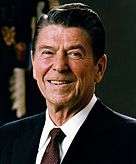
.jpg)


.jpg)

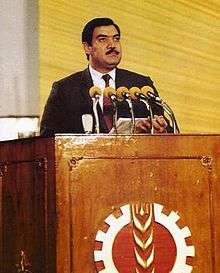




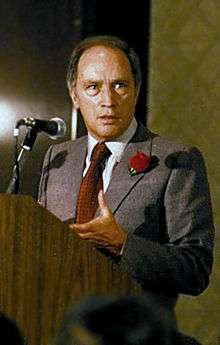






.jpg)
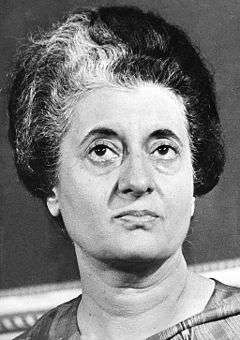
.jpg)


.jpg)






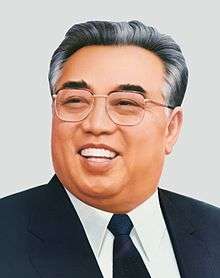

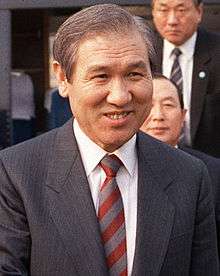

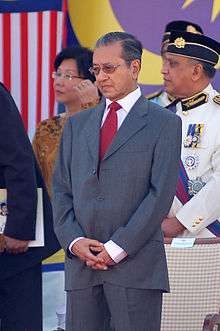

.jpg)


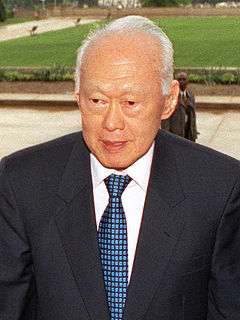




.jpg)

.jpg)
